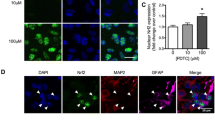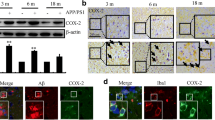Abstract
The cyclooxygenase (COX) superfamily of prostaglandin synthase genes encode a constitutively expressed COX-1, an inducible, highly regulated COX-2, and a COX-3 isoform whose RNA is derived through the retention of a highly structured, G + C-rich intron 1 of the COX-1 gene. As generators of oxygen radicals, lipid mediators, and the pharmacological targets of nonsteroidal anti-inflammatory drugs (NSAIDs), COX enzymes potentiate inflammatory neuropathology in Alzheimer's disease (AD) brain. Because COX-2 is elevated in AD and COX-3 is enriched in the mammalian CNS, these studies were undertaken to examine the expression of COX-3 in AD and in [IL-1β 1 Aβ42]-triggered human neural (HN) cells in primary culture. The results indicate that while COX-2 remains a major player in propagating inflammation in AD and in stressed HN cells, COX-3 may play ancillary roles in membrane-based COX signaling or when basal levels of COX-1 or COX-2 expression persist.
Similar content being viewed by others
REFERENCES
Chandrasekharan, N. V., Dai, H., Roos, K. L., Evanson, N. K., Tomsik, J., Elton, T. S., and Simmons D. L. 2002. COX-3, a cyclooxygenase-1 variant inhibited by acetaminophen and other analgesic/antipyretic drugs: cloning, structure, and expression. Proc. Natl. Acad. Sci. USA 99:13926–13931.
Dinchuk, J. E., Liu, R. Q., and Trzaskos, J. M. 2003. COX-3: in the wrong frame in mind. Immunol. Lett. 86:121.
Senior, K. 2002. Homing in on COX-3-the elusive target of paracetamol. Lancet Neurol. 1:399.
Warner, T. D. and Mitchell, J. A. 2002. Cyclooxygenase-3 (COX-3): filling in the gaps toward a COX continuum? Proc. Natl. Acad. Sci. USA 99:13371–13373.
Bazan, N. G., Colangelo, V., and Lukiw, W. J. 2002. Prostaglandins and other lipid mediators in Alzheimer’s disease. Prostaglandins and Other Lipid Mediators 68–69:197–210.
Bazan, N. G., Palacios-Pelaez, R., and Lukiw, W. J. 2002. Hypoxia signaling to genes: significance in Alzheimer’s disease. Mol. Neurobiol. 26:283–298.
Colangelo, V., Schurr, J., Ball, M. J., Pelaez, R. P., Bazan, N. G., and Lukiw, W. J. 2002. Gene expression profiling of 12633 genes in Alzheimer hippocampal CA1: transcription and neurotrophic factor down-regulation and up-regulation of apoptotic and pro-inflammatory signaling. J. Neurosci. Res. 70:462–473.
Bazan, N. G. and Lukiw, W. J. 2002. Cyclooxygenase-2 and presenilin-1 gene expression induced by interleukin-1beta and amyloid beta 42 peptide is potentiated by hypoxia in primary human neural cells. J. Biol. Chem. 277:30359–30367.
Xiang, Z., Ho, L., Yemul, S., Zhao, Z., Qing, W., Pompl, P., Kelley, K., Dang, A., Qing, W., Teplow, D., and Pasinetti, G. M. 2002. Cyclooxygenase-2 promotes amyloid plaque deposition in a mouse model of Alzheimer’s disease neuropathology. Gene Expr. 10:271–278.
Yasojima, K., Schwab, C., McGeer, E. G., and McGeer, P. L. 1999. Distribution of cyclooxygenase-1 and cyclooxygenase-2 mRNAs and proteins in human brain and peripheral organs. Brain Res. 830:226–236.
Kingsbury, A. E., Foster, O. J., Nisbet, A. P., Cairns, N., Bray, L., Eve, D. J., Lees, A. J., and Marsden, C. D. 1995. Tissue pH as an indicator of mRNA preservation in human post-mortem brain. Mol. Brain. Res. 28:311–318.
Heyman, A., Fillenbaum, G. G., Welsh-Bohmer, K. A., Gearing, M., Mirra, S. S., Mohs, R. C., Peterson, B. L., and Pieper, C. F. 1998. Cerebral infarcts in patients with autopsy-proven Alzheimer’s disease: CERAD, part XVIII. Consortium to Establish a Registry for Alzheimer’s Disease. Neurology 51:159–162
Newell, K. L., Hyman, B. T., Growdon, J. H., and Hedley-Whyte, E. T. 1999. Application of the National Institute on Aging (NIA)-Reagan Institute criteria for the neuropathological diagnosis of Alzheimer disease. J. Neuropathol. Exp. Neurol. 58:1147–1155.
Morris, J. C. and Price, J. L. 2001. Pathological correlates of nondemented aging, mild cognitive impairment and early stage Alzheimer’s disease. J. Mol. Neurosci. 17:101–118.
Lukiw, W. J. and Bazan, N. G. 1997. Cyclooxygenase 2 RNA message abundance, stability, and hypervariability in sporadic Alzheimer neocortex. J. Neurosci. Res. 50:937–945.
Lukiw, W. J. and Bazan, N. G. 1998. Strong nuclear factor-kappaBDNA binding parallels cyclooxygenase-2 gene transcription in aging and in sporadic Alzheimer’s disease superior temporal lobe neocortex. J. Neurosci. Res. 53:583–592.
McGeer, P. L. and McGeer, E. G. 2002. Local neuroinflammation and the progression of Alzheimer’s disease. J. Neurovirol. 8:529–538
Hoozemans, J. J., Veerhuis, R., Janssen, I., van Elk, E. J., Rozemuller, A. J., and Eikelenboom, P. 2002. The role of cyclooxygenase 1 and 2 activity in prostaglandin E(2) secretion by cultured human adult microglia: implications for Alzheimer’s disease. Brain Res. 951:218–226.
Gupta, A. and Pansari, K. 2003. Inflammation and Alzheimer’s disease. Int. J. Clin. Pract. 57:36–39.
Grammas, J., Yamada, M., and Zlokovic, B. 2002. The cerebromicrovasculature: a key player in the pathogenesis of Alzheimer’s disease. J. Alzheimers Dis. 4:217–23.
Newman, J. C. and Weiner, A. 2002. Measuring the immeasurable. Mol. Cell. 10:437–439.
Wei, S. and To, S. S. 2003. Influence of RNA secondary structure on HEV gene amplification using reverse-transcription and nested polymerase chain reaction. J. Clin. Virol. 27:152–161.
Nagel, J. H. and Pleij, C. W. 2002. Self-induced structural switches in RNA. Biochimie 84:913–923.
Author information
Authors and Affiliations
Rights and permissions
About this article
Cite this article
Cui, JG., Kuroda, H., Chandrasekharan, N.V. et al. Cyclooxygenase-3 Gene Expression in Alzheimer Hippocampus and in Stressed Human Neural Cells. Neurochem Res 29, 1731–1737 (2004). https://doi.org/10.1023/B:NERE.0000035809.70905.8a
Issue Date:
DOI: https://doi.org/10.1023/B:NERE.0000035809.70905.8a




